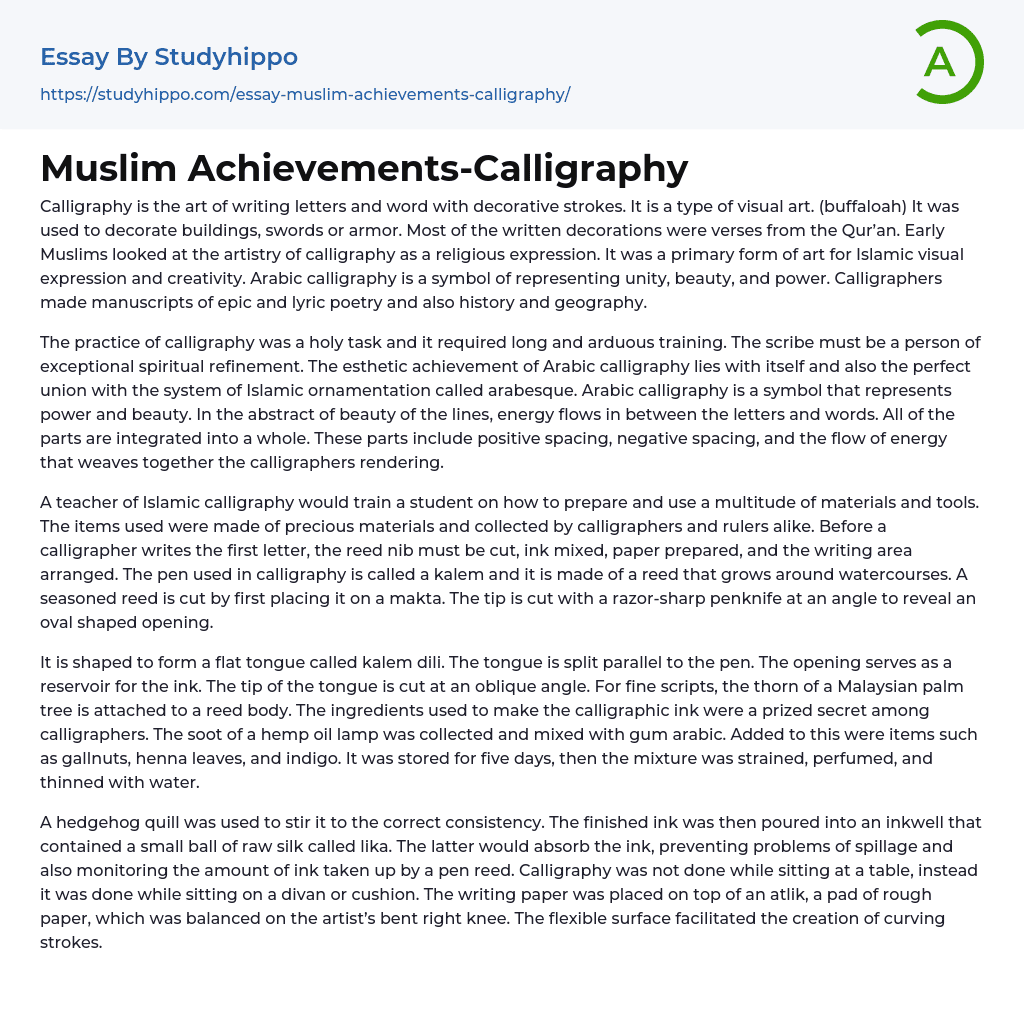Calligraphy is the art of writing letters and word with decorative strokes. It is a type of visual art. (buffaloah) It was used to decorate buildings, swords or armor. Most of the written decorations were verses from the Qur’an. Early Muslims looked at the artistry of calligraphy as a religious expression. It was a primary form of art for Islamic visual expression and creativity. Arabic calligraphy is a symbol of representing unity, beauty, and power. Calligraphers made manuscripts of epic and lyric poetry and also history and geography.
The practice of calligraphy was a holy task and it required long and arduous training. The scribe must be a person of exceptional spiritual refinement. The esthetic achievement of Arabic calligraphy lies with itself and also the perfect union with the system o
...f Islamic ornamentation called arabesque. Arabic calligraphy is a symbol that represents power and beauty. In the abstract of beauty of the lines, energy flows in between the letters and words. All of the parts are integrated into a whole. These parts include positive spacing, negative spacing, and the flow of energy that weaves together the calligraphers rendering.
A teacher of Islamic calligraphy would train a student on how to prepare and use a multitude of materials and tools. The items used were made of precious materials and collected by calligraphers and rulers alike. Before a calligrapher writes the first letter, the reed nib must be cut, ink mixed, paper prepared, and the writing area arranged. The pen used in calligraphy is called a kalem and it is made of a reed that grows around watercourses. A seasoned reed is cu
by first placing it on a makta. The tip is cut with a razor-sharp penknife at an angle to reveal an oval shaped opening.
It is shaped to form a flat tongue called kalem dili. The tongue is split parallel to the pen. The opening serves as a reservoir for the ink. The tip of the tongue is cut at an oblique angle. For fine scripts, the thorn of a Malaysian palm tree is attached to a reed body. The ingredients used to make the calligraphic ink were a prized secret among calligraphers. The soot of a hemp oil lamp was collected and mixed with gum arabic. Added to this were items such as gallnuts, henna leaves, and indigo. It was stored for five days, then the mixture was strained, perfumed, and thinned with water.
A hedgehog quill was used to stir it to the correct consistency. The finished ink was then poured into an inkwell that contained a small ball of raw silk called lika. The latter would absorb the ink, preventing problems of spillage and also monitoring the amount of ink taken up by a pen reed. Calligraphy was not done while sitting at a table, instead it was done while sitting on a divan or cushion. The writing paper was placed on top of an atlik, a pad of rough paper, which was balanced on the artist’s bent right knee. The flexible surface facilitated the creation of curving strokes.
- Creativity essays
- Art History essays
- Theatre essays
- Pastoral essays
- Visual Arts essays
- Postmodernism essays
- Symbolism essays
- ballet essays
- Color essays
- Modernism essays
- Mona Lisa essays
- Work of art essays
- Body Art essays
- Artist essays
- Cultural Anthropology essays
- Ethnography essays
- Aesthetics essays
- Realism essays
- Heritage essays
- Harlem Renaissance essays
- Concert Review essays
- Voice essays
- Theatre Of The Absurd essays
- Playwright essays
- Scotland essays
- Tennessee williams essays
- Design essays
- Graffiti essays
- Graphic essays
- Typography essays
- Painting essays
- Photography essays
- Sculpture essays
- Architecture essays
- Interior design essays
- Arch essays
- Area essays
- Tattoo essays
- Pablo Picasso essays
- Vincent Van Gogh essays
- Michelangelo essays
- Frida Kahlo essays
- John Locke essays
- 9/11 essays
- A Good Teacher essays
- A Healthy Diet essays
- A Modest Proposal essays
- A&P essays
- Academic Achievement essays
- Achievement essays




